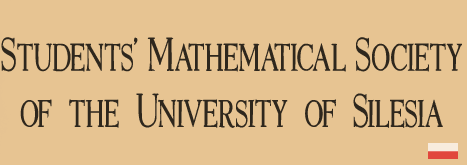Arguments between "pure mathematicians" and the "applied" ones remind me of discussions concerning the superiority of Christmas over Easter. However, the notion of "applications" of mathematics exists - quite a few times physics, economics or information technology appeared on the SMS sessions. This time we decided to let the participants go all out and we named the session simply "Applications of mathematics". We feared that the topic may be understood in various ways, but, as it turned out, none of the talkers strayed away from the three aforementioned branches of science, in which we usually apply mathematics. Below is the list of talks:
- R/S analysis for Polish capital market (Ireneusz Kmin)
- ARCH type models (Łukasz Szpruch)
- The Markovitz model for insurance portfolio (Monika Wi¶niewska)
- One- and two-period model of insurance with reasecuratio (Mariusz Górajski)
- Hilbert spaces and quantum mechanics (Pola Siwek)
- Information theory and coding (Piotr Krakowiak)
- Relations - differently (Adam Kolany)
- Stochastic Control, i.e. how to choose an optimal partner (Rafał Kucharski)
- The integral transforms method of solving differential equations concerning problems from physics and technology (Tomasz Kochanek)
- Game theory in economics, philosophy and politics (Wirginia Wyrobek)
- The simplex method (Renata Kawa)
- The fractional Brown motion in insurances (Michał Seweryn)
Concerning things outside of science, this session will unfortunately remain in our memory as one of the worse - it was our third session in Ustroń and proably the last one. We were unpleasantly surprised with the lack of water. The lack itself would not probably be such a nuisance if it wasn't for quite weird behavior of the hosts of our hostel in this situation.
On the other hand we had marvelous weather: we went to Czantoria in quite a big group, and in accordance with vox populi we went back through a "shortcut", which was an unforgettable experience.
There also appeared quite a real problem from the applications of mathematics, given by Piotrek. It should interest the student community, so we enclose it below:
Three friends wanted to quench their thirst in the municipal park. They went there with a 0,5l bottle of vodka (non-alcoholic, of course :)) and 1l bottle of juice. Unfortunately, they didn't have any mug or other container, which would serve them for making drinks. One of them posed a solution: he would drink some juice, and then refill the bottle with vodka; he would repeat this operation (drinking a mix of vodka and juice from the second step onwards) until he runs out of vodka to pour into the bottle of juice. He would drink no more than he would refill (so that after each cycle the bottle wth drink was full) and he would always refill the bottle to the full with vodka. After ending this operation, the two other friends would drink the mix (the third one already drank his share of 0,5l from the 1,5l they have). An obvious question appears: can he drink and refill in such a way to drink at least 1/3 of their vodka (so that he gains something from his "sacrifice")? What strategy should he use to drink as much vodka as possible? Does an optimal strategy exist?
We came up with partial answers, but we await your soultions of this problem.
Any similarities to real-life situations are purely coincidential.
last update: 13.01.2011

